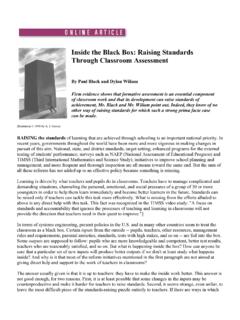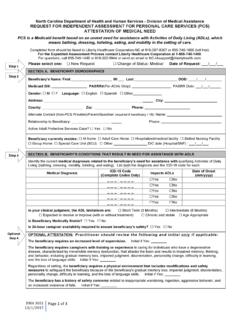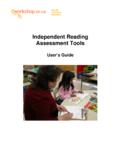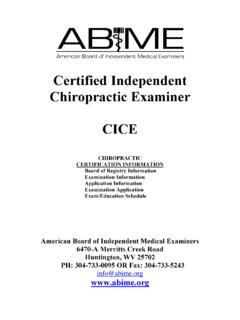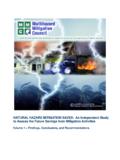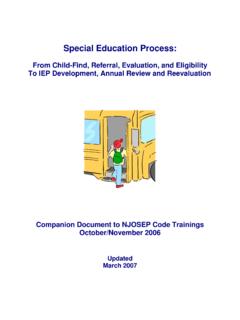Transcription of Assessment for Learning: Reconsidering Portfolios and ...
1 Assessment for learning : Reconsidering Portfolios and Research Evidence By Anne Davies and Paul Le Mahieu Only if we expand and reformulate our view of what counts as human intellect will we be able to devise more appropriate ways of assessing it and more effective ways of educating it. Howard Gardner Introduction Since the late 1980's, public education in North America has been shifting to a standards or outcomes based and performance oriented systems. Within such systems, the most basic purpose of all education is student learning , and the primary purpose of all Assessment is to support that learning in some fashion. The Assessment reform that began in the 1980's in North America has had numerous impacts. Most significantly, it has changed the way educators think about students'.
2 Capabilities, the nature of learning , the nature of quality in learning , as well as what can serve as evidence of learning in terms of classroom Assessment , teacher Assessment and large-scale Assessment . In this context, the use of Portfolios as a mode of Assessment has gained a lot of interest. This chapter will explore the role of Assessment in learning and the role Portfolios might play. Research evidence of the qualities of Portfolios for enhancing student learning is presented and discussed. The Role of Assessment in learning learning occurs when students are, thinking, problem-solving, constructing, transforming, investigating, creating, analyzing, making choices, organizing, deciding, explaining, talking and communicating, sharing, representing, predicting, interpreting, assessing, reflecting, taking responsibility, exploring, asking, answering, recording, gaining new knowledge, and applying that knowledge to new situations.
3 (Cameron et al. 1998, p 6) The primary purpose of student Assessment is to support this learning . learning is not possible without thoughtful use of quality Assessment information by learners. This is reflected in Dewey's (1933) learning loop, Lewin's (1952) reflective spiral, Sch n's (1983) reflective practitioner, Senge's (1990) reflective Davies, A, & Le Mahieu, P. (2003). Assessment for learning : Reconsidering Portfolios and research evidence. In M. Segers, F. Dochy, & E. Cascallar (Eds.), Innovation and Change in Professional Education: Optimising New Modes of Assessment : In Search of Qualities and Standards (p. 141-169). Dordrecht: Kluwer Academic Publishers. page 1. feedback, and Wiggin's (1993) feedback loop. Education (K-12 and higher education) tends to hold both students and teachers responsible for learning .
4 Yet, if students are to learn and develop into life long, independent, self-directed learners they need to be included in the Assessment process so the learning loop' is complete. Reflection and Assessment are essential for learning . In this respect, the concept of Assessment for learning as opposed to Assessment of learning , has emerged. For optimum learning to occur students need to be involved in the classroom Assessment process. When students are involved in the Assessment process they are motivated to learn. This appears to be connected to choice and the resulting ownership. When students are involved in the Assessment process they learn how to think about their learning and how to self-assess key aspects of meta- cognition. Learners construct their own understandings therefore, learning how to learn - becoming an independent, self-directed, life long learner - involves learning how to assess and learning to use Assessment information and insights to adjust learning behaviors and improve performance.
5 Students' sense of quality in performance and expectations of their own performance are increased as a result of their engagement in the Assessment process. When students are involved in their learning and Assessment they have opportunities to share their learning with others whose opinions they care about. An audience gives purpose and creates a sense of responsibility for the learning which increases the authenticity of the task (Gregory et al, 2001; Sizer, 1996; Davies et al, 1992). Students can create more comprehensive collections of evidence to demonstrate their learning because they know and can represent what they've learned in various ways to serve various purposes. This involves gathering evidence of learning from a variety of sources over time and looking for patterns and trends.
6 The validity and reliability of classroom Assessment is increased when students are involved in collecting evidence of learning . The collections are more likely to be more complete and comprehensive than if teachers alone collect evidence of learning . Additionally, this increases the potential for instructionally relevant insights into learning . Teachers employ a range of methods to collect evidence of student learning over time. When evidence is collected from three different sources over time, trends and patterns can become apparent. This process has a history of use in the social sciences and is called triangulation (Lincoln and Guba 1984). As students learn, evidence of learning is created. One source of evidence are products such as tests, assignments, students'.
7 Writings, projects, notebooks, constructions, images, demonstrations, as well as photographs, video, and audiotapes. They offer evidence of students' performances of various kinds across various Davies, A, & Le Mahieu, P. (2003). Assessment for learning : Reconsidering Portfolios and research evidence. In M. Segers, F. Dochy, & E. Cascallar (Eds.), Innovation and Change in Professional Education: Optimising New Modes of Assessment : In Search of Qualities and Standards (p. 141-169). Dordrecht: Kluwer Academic Publishers. page 2. subject areas. Observing the process of learning includes observation notes regarding hands-on, minds-on learning activities as well as learning journals. Talking with students about their learning includes conferences, written self assessments, and interviews.
8 Collecting products, observing the process of learning , and talking with students provides a considerable range of evidence over time Taking these critical success factors of learning into account, portfolio as a mode of Assessment poses unique challenges. portfolio and its characteristics Gillespie et al (1996) offers the following definition: portfolio Assessment is a purposeful, multidimensional process of collecting evidence that illustrates a student's accomplishments, efforts, and progress (utilizing a variety of authentic evidence) over time. (p. 487) In fact, Portfolios are so purposive that everything that defines a portfolio system: What is collected; Who collects it; How it is collected; Who looks at it; How they look at it; and What they do with what they see are all determined first by the purpose for the portfolio .
9 Consider, for example, a portfolio with which one will seek employment. While there must be no duplicity in the evidence presented, it would seem perfectly acceptable, even expected, that the candidates will present themselves in the best possible light. What is most likely to find its way into such a portfolio is a finished product and often the best product at that. On the other hand, consider a portfolio with which a student reveals to a trusted teacher a completely balanced appraisal of his or her learning : strengths, certainly, but also weaknesses as well as the kinds of processes the learner uses to produce his or her work. This portfolio is likely to have a number of incomplete efforts, some missteps, and some product that reveals current learning needs.
10 This is not the sort of portfolio with which one would be comfortable seeking employment. The point is a simple one: while they appear similar in many respects, Portfolios are above all else purposive and everything about them derives from their desired purpose. This is why some frank discussion about purpose at the outset of developing a portfolio system is essential. Often, when teachers feel blocked about some decision about their portfolio process, the answer is apparent upon remembering their purpose. There is no one or best specific purpose for Portfolios . Portfolios can be used to show growth over time ( Politano, 1997; Tierney et al, 1991; Elbow, 1986), to provide Assessment information that Davies, A, & Le Mahieu, P. (2003). Assessment for learning : Reconsidering Portfolios and research evidence.
